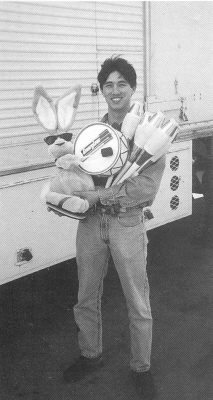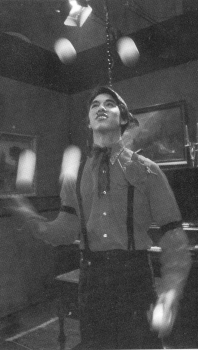
Hart's success includes juggling in a commercial with the Energizer Bunny. |

Hart's "unique look" allow him to fit into many roles, including an Old West saloon performer. |
Page 23 Winter '97 - Spring '98
|
He developed his love of the manipulative arts without much conscious prodding, either. He said, "I'd throw knives into a big avocado tree in our back yard, and also build card houses. Really big card houses. That takes time and concentration, and you could say there's no really good reason for doing it. A lot of things in juggling are that way, too, where there's no really important reason for you to learn a particular trick except as a challenge."
He began juggling at age 13 while enrolled in a summer enrichment program for children of Hawaiian ancestry. "I missed the juggling class because it was the same time as the massage workshop, and I was always into love and touch and sensuality, " he recalled. "But afterwards, there were people in the yard practicing juggling and the instructor showed me the cascade and a couple of tricks. Back home I continued to practice. Trying to figure out new patterns was fun. I even thought I'd invented the five-ball bounce."
He was prompted to begin juggling professionally as he watched a magician-juggler perform at a family party on the military base where he lived from age seven onward. "I can to better than that," he said, and soon he was performing for events on the base.
But his family resisted his desire to study theatre arts full time after high school graduation, preferring that he learn computer science. When he persisted, they told him he could do it on his own, and gave him a ticket to the States and a thousand dollars as a high school graduation present. Since the age of 18, he has made his living entirely through performing arts.
He was accepted by both the prestigious American Academy of Dramatic Arts in Los Angeles (the same school that trained Kirk Douglas, Tony Curtis, and Tom Cruise) and the Ringling Brothers and Barnum & Bailey Clown College, associated with the Ringling Brothers Circus. Deciding between them was a tough choice for the 17-year-old. Though his record of success at amateur speech and theater, as well as a couple of television credits, might have made the Academy the more obvious choice, Hart feared he would be limited in acting by ethnic prejudice. "Think about it," he said. "When was the last time you saw an Asian or Eurasian male kissing a female on TV or in film?"
In juggling and variety entertainment, on the other hand, he felt that his legitimate skills would be recognized, and he could get more work. So he enrolled in the Ringling School, and followed it with a stint as a street performer in San Francisco. He soon found opportunities opening up across the Pacific. He said, "I was hanging out at Robert Nelson's house watching Wheeler Cole scrape paint when I heard about this amusement park job in Japan that Daniel Menendez had turned down. I got the job. Of course, I didn't speak the language yet, but at age 19 it all was pretty neat."
That's how it all started, but since then he has developed performance skills for large as well as more intimate settings. His western-style skill repertoire includes throw and catch juggling of all implements, magical illusions and stilt walking. He also presents a Hawaiian-style entertainment package showcasing his skills at fire-knife dancing, fire eating, and knife throwing. He performs at private parties thrown by luminaries such as George Lucas, and has been hired for shows in Tokyo, Hiroshima, Osaka, Seoul and Bahrain.
By forming David Hart & Associates, he broadened his marketing strategy to developing entire productions, and began putting out casting calls for other performers to fill requests. Hart has acted as booking agents for promotional events for corporate clients like Coca Cola, Bank of America, Coors, Apple Computer and Kodak, providing employment for other artists. He said, "At one point I had 30 subcontractors, including other jugglers, magicians, comedians, fire eaters, mimes, clowns, caricaturists, face painters, stilt walkers and unicyclists."
Running his own business allowed him to squeeze in enough class time to complete college degrees in both theatre arts and general studies at the College of Marin. He continued his education at UCLA, where he conducted research in Polynesian variety entertainment. He concluded that the public perception of the style is riddled with fallacies. He explained, "What's called 'the Samoan fire-knife dance' is anything but a native Polynesian traditional performance art, whereas 'western-style' throw and catch juggling has been part of South Pacific culture for centuries. Bob Crossley's 1984 'Juggling' film clearly documents this. It shows that in Tonga the women's cultural tradition of juggling tui-tui nut, in a shower pattern in high numbers goes back many hundreds of years.
"The reality is that the fire-knife dance was created in 1936 when Samoan performer Freldie Letuli worked with a traveling circus that also featured Chinese jugglers performing with fire on the tips of their long batons. He soon incorporated this feat into his own act. Thus the 'traditional Samoan fire-knife dance' was born. Today it's become so institutionalized that 'World Championships' in the art are held yearly at the Polynesian Cultural Center on Oahu."
Building on the genuine South Pacific juggling heritage, Hart has won acceptance for his own brand of "western-style" juggling, presented in an exciting Polynesian context. Eager to transform the more limited attainments of the usual "fire-knife dancers," Hart doesn't restrict himself to their basic techniques. His show is unique in combining spear and knife twirling with throw-and-catch juggling techniques. Dangerous manipulations of the long "Siva Afi" fire knives are followed by displays of three, four, and five torch juggling.
To honor Pele, the Fire Goddess, Hart presses his tongue on a lit torch, then eats the fire. As an encore, he persuades a brave volunteer to lie down on the stage as a "sacrifice to the Gods," while Hart juggles machetes over the "victim's" supine body in a ritualistic test of bravery. |

Hart's success includes juggling in a commercial with the Energizer Bunny. |

Hart's "unique look" allow him to fit into many roles, including an Old West saloon performer. |